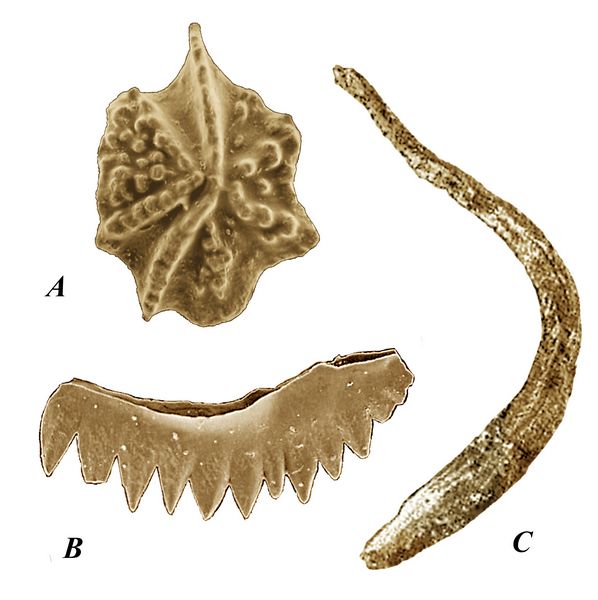Athena Review Image Archive ™
Conodonts: tooth elements and chordate body form

Conodonts A-C (SEM images from Leicester Univ.)
Conodonts are small, worm-shaped marine chordates found in Paleozoic deposits around the world, whose tooth-like elements for many years remained a mystery, until well-preserved whole specimens were discovered. The nane conodont means "cone teeth". They are in the phyllum chordata, the clade Craniata, the subphyllum Vertebrata, and the class Conodonta. The three examples (A-C) shown here date from the Early Silurian period, in the Llandovery stage, at 443-433 mya.
A shows tooth elements of the conodont Gamachignathus macroexcavatus, found in the Upper Member of the Xiushan Formation, Leijiatun Section near Shiqian, Guizhou Province, China.
B shows tooth elements of the conodont Apsidognathus tuberculatus from the Wych Formation in Gullet Quarry, Malvern Hills, UK.
C shows the full body of Promissum, the largest known conodont, which grew up to 16 inches long. Promissum is from the Soom Shale of South Africa.
The
highly specific forms of conodont tooth elements have allowed their
frequent use as index fossils in the Silurian and other periods.
References:
Gabbott, S.E., R. J. Aldridge, J. N. Theron 1995. A giant conodont with preserved muscle tissue from the Upper Ordovician of South Africa. Nature 374 pp.800–803
Leicester University: http:/www.ucl.ac.uk/GeolSci/micropal/conodont.html
Copyright © 1996-2020 Rust Family Foundation (All Rights Reserved).